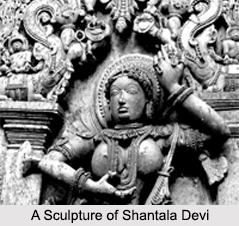 Shantala Devi was the wife of Vishnuvardhana, a king of the well-known Hoysala dynasty of the ancient Karnataka in the 12th century AD. Queen Shantala Devi was well versed in fine arts. She excelled in dancing, singing and instrumental music. More specifically, she was well trained in a dance form called Bharatnatyam. She was a follower of a religion namely, Jainism. It is said that Vishnuvardhana too was originally a Jain. He converted to Sri Vaishnavism under the influence of Ramanujacharya, the great Sri Vaishnava teacher, but Vishnuvardhana continued to patronize Jainism. Earlier, many books had been written on the valor and capability of the king. But hardly anything was written about the queen.
Shantala Devi was the wife of Vishnuvardhana, a king of the well-known Hoysala dynasty of the ancient Karnataka in the 12th century AD. Queen Shantala Devi was well versed in fine arts. She excelled in dancing, singing and instrumental music. More specifically, she was well trained in a dance form called Bharatnatyam. She was a follower of a religion namely, Jainism. It is said that Vishnuvardhana too was originally a Jain. He converted to Sri Vaishnavism under the influence of Ramanujacharya, the great Sri Vaishnava teacher, but Vishnuvardhana continued to patronize Jainism. Earlier, many books had been written on the valor and capability of the king. But hardly anything was written about the queen.
Contributions of Shantala Devi
Queen Shantala Devi is credited with the establishment of a temple namely, Channigaraya Temple, based on the lines of Chennakeshava Temple. She had also established the Savathi Gandavara Temple in Chandragiri at Shravanabelagola. She is known to donate a village namely, Mottenavile Village to her preceptor namely, Prabhachandrasiddanthadevaru for conducting rituals. Shantala Devi had played a great role in the cultural and religious spheres in both north and south India.
Titles Received by Shantala Devi
Queen Shantala Devi was crowned in 1117 as Pattamahadevi. She had received many titles like the "crest jewel of perfect faith", "a rampart of the Jain faith", "the goddess of victory in battle" and the "goddess of wealth and fame in peace".
Temples Built to Commemorate Shantala Devi
Inspired by Shantala Devi"s beauty, king Vishnuvardhana had built numerous celestial female figures called `Madanikas` in the temple of Chennakeshava in Belur, Karnataka. As per estimations, there are about forty-two `Madanikas`. Shantala Devi was an epitome of beauty and sculptors were also inspired by her grace. Hence, sculptures were carved meticulously and all of them are in poses of Bharatanatyam. There is a polished stone platform in the hall of the Chennakeshava. It is said that Shantala Devi danced on this platform in praise of Lord Chennakeshava. King Vishnuvardhana had also built the `Sri Shantha-leswara` shrine at Shivaganga Bhetta to commemorate Shantala Devi.
It is said that Queen Shantala Devi died after observing the Jaina practice of `Sallekhana` at Shivaganga. It is also believed that she committed suicide by jumping off a hill namely, Shivaganga.



















